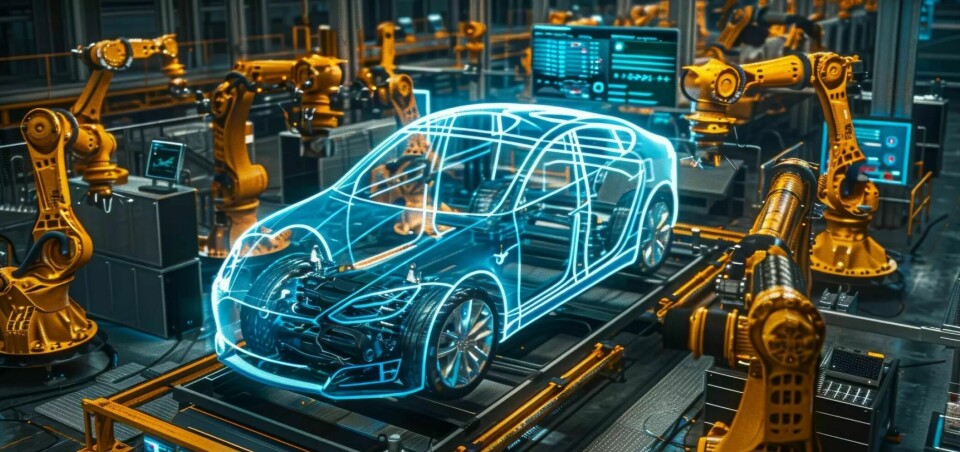New efficiency potentials
Is the automotive industry steering towards a factory-less future?
Innovative technologies like AI, robotics, and automation offer the automotive industry great opportunities: more efficiency, shorter development times, higher competitiveness. And an even more radical approach is sparking the interest of OEMs.

The consultants at Bain & Company have highlighted in a recent analysis how technological innovations have the potential to profoundly transform the automotive industry. Around 300 executives from European and North American automotive companies were surveyed. The widespread use of AI will be crucial in the future. In addition to efficiency advantages, it also brings qualitative improvements - for example, through AI-supported simulations and automations in software documentation.
“The consistent and combined use of innovative technologies such as automation, artificial intelligence, and robotics offers the automotive industry an opportunity that only comes once in a generation,” explains Bain partner Eric Zayer, who leads the automotive and mobility practice group in the EMEA region. He draws parallels to the phase of opening the Chinese market: “If manufacturers and suppliers quickly seize the new technological opportunities and fundamentally adapt their business and operating models, they can regain their former strength.”
What potential lies in fabless production?
The vision extends to fabless manufacturing - a model that over 80 percent of respondents are already considering. This refers to a production concept where companies forgo their own manufacturing facilities and instead commission external partners with production. Development, design, and control remain with the company, while physical production is outsourced - similar to the semiconductor industry.
With 94 percent, European manufacturers showed themselves to be particularly open here. The targeted advantages are particularly increased flexibility, lower capital commitment, and higher scalability. However, to realize this change, a clear technological vision and a corresponding data foundation are needed - two factors where many European companies are currently lagging behind.
Bain partner and industry expert Björn Noack calls on the industry to continue developing their business models despite possible resistance: "Every vehicle manufacturer and supplier needs a clear idea of how they will differentiate themselves from the competition in the future - this can range from modern manufacturing to superior design to the brand's charisma." The decline in EBIT margins to 6.8 percent for manufacturers and 6.6 percent for suppliers shows the growing pressure in the industry. Western European locations are particularly affected: their cost disadvantage compared to plants in Eastern Europe and China is 20 to 30 percent - in the development of e-car platforms even up to 85 percent.
This gap could only be closed if both established manufacturers and their suppliers significantly accelerate their digitization and automation. The potential in this is shown by further results of the Bain analysis: According to the respondents, a technology-driven transformation of manufacturing can increase efficiency by more than 30 percent in the next five years. In addition, a technology-based collaboration with suppliers could reduce development times for new models by more than 40 percent to around 30 months.
Humanoid robots conquer manufacturing
By 2035, the widespread use of AI is expected to further increase efficiency in the development and production of vehicles and components. "In particular, non-value-adding or low-value-adding but time-intensive activities, such as software coding documentation, can be reduced by up to 80 percent with the help of AI," explains Bain partner and automotive expert Dominik Foucar. "This saves both time and costs while simultaneously increasing quality for customers." More than 80 percent of respondents also believe that AI-supported simulations will enable dynamic real-time adjustments in manufacturing. Two-thirds also expect that humanoid robots will largely take over production in the coming decade.
So far, European and North American companies have largely operated on an equal footing in the use of technologies along the automotive value chain - the potential is generally recognized. However, while North American manufacturers are already working to realize concrete cost advantages from this, Europeans have been more reserved. For example, automakers in North America plan to achieve savings of up to 12 percent in labor costs in the administrative area over the next three years - their counterparts in Europe have pursued this goal far less decisively so far.
Insufficient data quality jeopardizes efficiency gains
According to the analysis, North American companies are significantly more convinced of the opportunities of technology-driven change than their European competitors, who see hurdles in areas such as data management. This reluctance, combined with insufficient data quality, endangers the targeted efficiency gains, according to Bain partner Noack: "In light of the current challenges, incremental improvements are no longer enough. The future of the automotive industry is digital - and this transformation requires a big leap." According to Zayer, even the showcase locations of the automotive industry are just at the transition from lean concepts to the digital factory. There is still a long way to go to autonomous manufacturing using AI and humanoid robots. Nevertheless, Zayer is optimistic: "The established automotive industry has the skills, financial resources, and the will to master the technology-driven change on its own - and to successfully assert itself in the emerging era of electromobility." It must now act decisively, invest sufficiently, and be ready to master even difficult steps.
